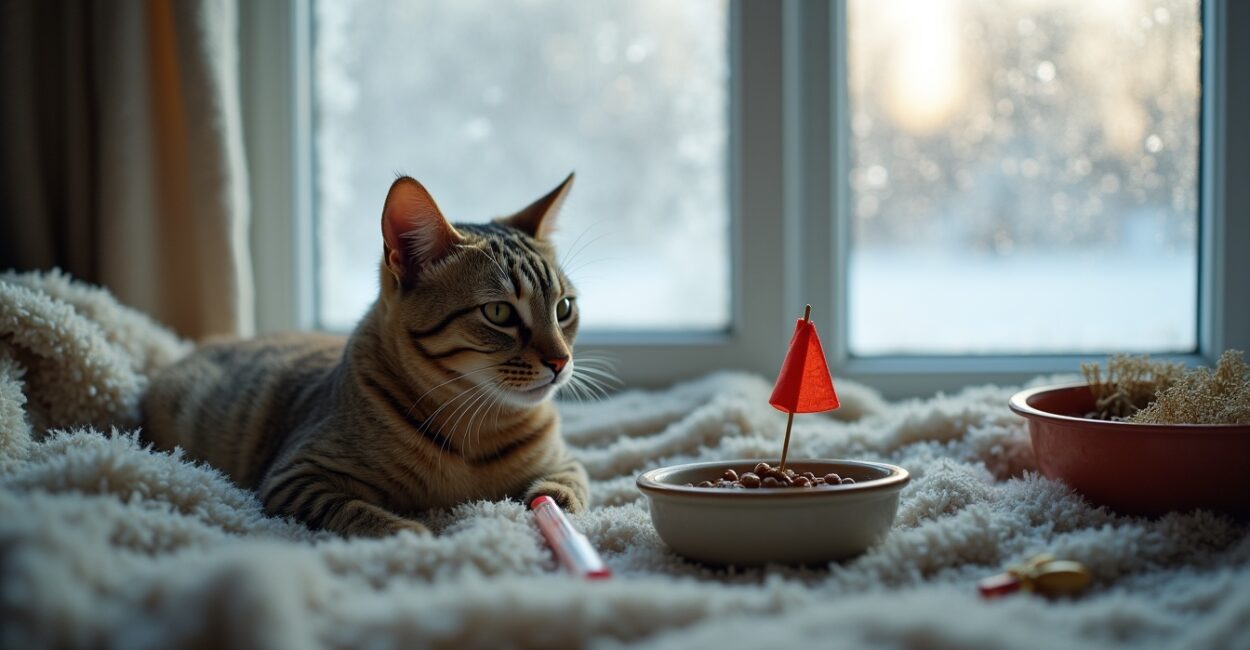You love your cat, but winter brings that quiet worry: something feels off and you can’t put your paw on it. You’re not paranoid — vets warn that subtle signs this season can spiral fast if ignored.
Read this now: I’ll reveal seven often-missed signals about cat health care vets say escalate over winter, plus quick fixes, red flags, and exactly when to race to the clinic. No fluff — just actionable, calming steps to keep your cat steady through cold months.
Cold-weather Red Flag: Cat Health Care Signs Vets Hate to See
When temperatures drop, small changes become big problems. Cats hide illness; that’s their instinct. So, notice weight loss, grazing changes, or a thinner coat? That’s a clue.
- Watch feeding patterns — decreased interest in food is urgent.
- Monitor litter box frequency — constipation or diarrhea can dehydrate fast.
- Check breathing at rest — any rapid, shallow breaths are a red flag.
Here’s the secret: a tiny change often precedes rapid decline. Act early.
Nutrition Shifts That Hide Illness
Food refusal, sudden cravings, or picky behavior in winter usually mean more than mood. Think metabolic changes, dental pain, or early kidney stress.
- Offer warm, aromatic wet food to tempt appetite.
- Keep protein high; older cats may need renal-friendly formulas.
- Rotate textures — pate vs. chunks — to expose chewing issues.
Don’t assume “old age.” Test before you resign to loss of appetite.

Respiratory Red Flags That Escalate Fast
Listen: wheeze, cough, sneezing with discharge, or open-mouth breathing are urgent in winter. Respiratory infections spread and can worsen quickly in indoor cats living close together.
But it’s not just colds — heart disease and asthma flare-ups mimic simple infections. If symptoms persist beyond 48 hours, seek vet care.
For trusted guidance, review these resources: CDC Pet Health and AVMA Cat Care.
Dental Pain: The Silent Winter Saboteur
Dental disease skyrockets unnoticed. Cats hide mouth pain by refusing dry food or dropping food from their mouth.
| Sign | Possible Cause |
|---|---|
| Pawing at face | Tooth root abscess |
| Drooling | Gingivitis or stomatitis |
| Weight loss | Painful chewing |
Think like a vet: inspect gums, watch eating, and don’t delay dental exams. A simple tooth extraction can restore months of appetite and comfort.

Dehydration and Subtle Behavior Shifts
Winter hides thirst — heaters dry air and cats drink less. Dehydration worsens kidney and urinary issues fast. Pinch test the scruff; slow skin return is a sign.
- Put multiple water sources around the house.
- Use a cat fountain — flowing water boosts intake.
- Tempt with broths (no onion/garlic) for added fluids.
Pense comigo: behavior changes like hiding, reduced grooming, or irritability often follow dehydration. Act before the next vet visit becomes an emergency.
Vaccination Lapses and Infection Risks
Missed boosters open doors to serious diseases that are easier to catch when cats cluster indoors. Indoor-only doesn’t mean risk-free — visitors, other pets, and fomites matter.
Here’s the practical step: review your cat’s vaccine history this month and schedule overdue boosters. For evidence-backed schedules, see trusted public health guidance.
When “wait and See” Becomes Reckless
Every vet hears it: “I’ll watch tonight.” But winter accelerates decline. Know these emergency triggers: labored breathing, collapse, unresponsive fever, repeated vomiting, or sudden severe pain.
- Take immediate action for breathing issues or collapse.
- Transport gently; keep the cat warm but ventilated.
- Call ahead so the clinic prepares — that saves minutes that matter.
Here’s the clincher: early intervention can mean the difference between outpatient care and critical hospitalization.
What to avoid
- Delaying a vet visit because it’s “probably nothing.”
- Giving human meds without vet approval.
- Ignoring subtle grooming or appetite changes.
These seven silent signs are not hypothetical — they’re the cases vets see worsen every winter. You can catch most of them early with observation, simple at-home fixes, and prompt vet contact.
Do you feel ready to act? Trust your instincts, and treat subtle shifts as invitations to check deeper. Your cat’s quiet tells are the most important messages you’ll get this season.
What Signs of Respiratory Trouble Should I Never Ignore?
Rapid, shallow breathing, open-mouth breathing, blue or pale gums, and persistent coughing or wheeze are emergencies. If your cat shows any of these, seek immediate veterinary attention. Early treatment for infections, asthma, or heart-related issues prevents rapid deterioration, especially during winter when indoor air and close contact raise transmission risk.
How Often Should I Update Vaccinations for Winter Protection in Cat Health Care?
Vaccination schedules vary by age, lifestyle, and risk. Adult cats typically need core boosters every 1–3 years per vet advice. Indoor-only cats still require core vaccines and a vet’s risk assessment. Review records annually and consult your veterinarian before winter to close any gaps and reduce infection risk indoors.
Can Dental Pain Really Cause Appetite Loss and Weight Loss?
Absolutely. Dental disease makes chewing painful, so cats drop hard food or eat less. Chronic oral pain leads to progressive weight loss, dehydration, and decreased grooming. A dental exam and cleaning—or extractions when needed—often restore appetite quickly. Don’t dismiss sudden food preferences as mere pickiness.
What Are Quick At-home Steps to Prevent Dehydration This Winter?
Place multiple water bowls around the house, use a cat fountain to encourage drinking, warm wet food to release aroma and fluids, and offer unsalted bone broth (no onions/garlic). Monitor urine output and skin elasticity. If you see reduced drinking combined with lethargy, contact your vet; subcutaneous fluids may be needed promptly.
When Should I Go to Emergency Care Instead of Waiting for a Regular Appointment?
Go to emergency care for collapse, severe trauma, difficulty breathing, repeated vomiting, uncontrolled bleeding, seizures, or when your cat is non-responsive. Also seek urgent help for sudden high fever, severe pain, or if you notice disorientation. Winter can turn minor signs into major problems fast—err on the side of prompt evaluation.

